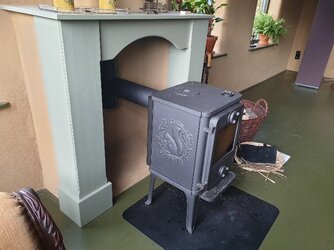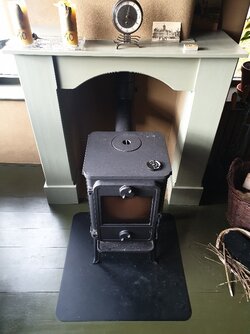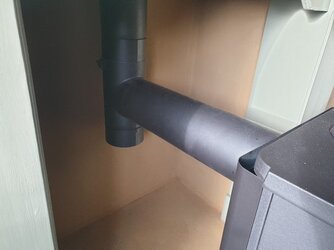Hi, I'm new to wood stoves and installed the flue and wood stove myself. I have a problem with smoke entering my room when opening the stove door for re-fuelling. Let me first describe how my system looks like:
We have a Morsoe 1412 stove in an old house. The masonry chimney is about 5 meters tall and I used a flexible, double wanded stainless steel flue pipe which I put into the masonry chimney. The fireplace has a concrete plate at 1 meter height with a 12 cm hole where a 2 mm thick iron flue pipe is connected to the flexible double wanded flue pipe. I used a 90 degree T piece to convert from vertical to horizontal flue pipe as I use the rear connection of my Morsoe 1412 stove. The reason for using the rear connection is otherwise we have to put the stove inside the mantelpiece which had some wooden parts, so we want to keep the stove at distance from this part. We therefore put the stove about 15 cm in front of the front side of the mantelpiece.
When opening the stove door, over 50% of the time smoke is visibly coming out of the stove, which creates an unpleasant smell in my room. Things I've tried without effort:
* opening the door only when temperature is high enough
* opening the door just a few cm's, waiting a moment and slowly opening it further
* re-fuelling as quick as possible
* crack a window before opening stove door
* waiting for the flames to disappear, loading the new wood onto the glowing coals
I would think draft would be ok as I can hear a constant blowing / airflow from the top (secondary) air intake. But as this is a modern stove which has a baffle which directs the flames to the top front of the stove (door), to me it seems not that strange that smoke is getting into my room when opening the door. My dad has a (different) modern stove as well and he has the same problem of smoke entering the room when opening the stove door.
I'm wondering what could be the cause and solution to this problem? The only thing I can come up with is raising the draft although I doubt that draft is too low. I have a 12 cm diameter flue, total length is about 6 meters. I've read that the horizontal part of the 90 degree T part should not exceed 15 cm length. I measured mine and it measures 40 cm. Would this greatly affect draft? If so, could this be the cause? I've also read (after installing my stove and experiencing the smoke problem) that the top connection of the stove is alway preferable to the read connection as smoke prefers to go up rather than move in horizontal direction.
Maybe I'm completely wrong, or there are other causes? I hope you can help me. If needed I can supply photo's or drawings of my system. I use seasoned, dry firewood. (I didn't measure moisture content)
We don't have any mechanical ventilation system in our home. We have another chimney in our house, which has two separate sides, 1 is covered (not in use), the other is connected to a gas stove.
We have a Morsoe 1412 stove in an old house. The masonry chimney is about 5 meters tall and I used a flexible, double wanded stainless steel flue pipe which I put into the masonry chimney. The fireplace has a concrete plate at 1 meter height with a 12 cm hole where a 2 mm thick iron flue pipe is connected to the flexible double wanded flue pipe. I used a 90 degree T piece to convert from vertical to horizontal flue pipe as I use the rear connection of my Morsoe 1412 stove. The reason for using the rear connection is otherwise we have to put the stove inside the mantelpiece which had some wooden parts, so we want to keep the stove at distance from this part. We therefore put the stove about 15 cm in front of the front side of the mantelpiece.
When opening the stove door, over 50% of the time smoke is visibly coming out of the stove, which creates an unpleasant smell in my room. Things I've tried without effort:
* opening the door only when temperature is high enough
* opening the door just a few cm's, waiting a moment and slowly opening it further
* re-fuelling as quick as possible
* crack a window before opening stove door
* waiting for the flames to disappear, loading the new wood onto the glowing coals
I would think draft would be ok as I can hear a constant blowing / airflow from the top (secondary) air intake. But as this is a modern stove which has a baffle which directs the flames to the top front of the stove (door), to me it seems not that strange that smoke is getting into my room when opening the door. My dad has a (different) modern stove as well and he has the same problem of smoke entering the room when opening the stove door.
I'm wondering what could be the cause and solution to this problem? The only thing I can come up with is raising the draft although I doubt that draft is too low. I have a 12 cm diameter flue, total length is about 6 meters. I've read that the horizontal part of the 90 degree T part should not exceed 15 cm length. I measured mine and it measures 40 cm. Would this greatly affect draft? If so, could this be the cause? I've also read (after installing my stove and experiencing the smoke problem) that the top connection of the stove is alway preferable to the read connection as smoke prefers to go up rather than move in horizontal direction.
Maybe I'm completely wrong, or there are other causes? I hope you can help me. If needed I can supply photo's or drawings of my system. I use seasoned, dry firewood. (I didn't measure moisture content)
We don't have any mechanical ventilation system in our home. We have another chimney in our house, which has two separate sides, 1 is covered (not in use), the other is connected to a gas stove.




